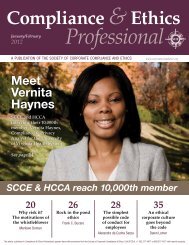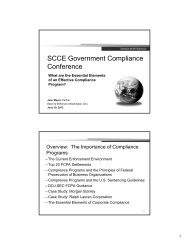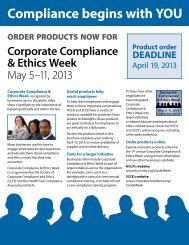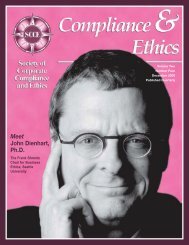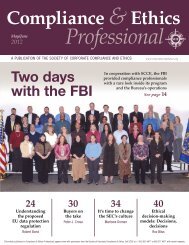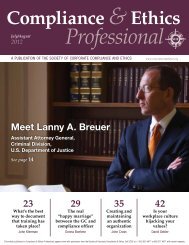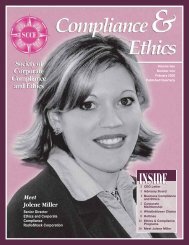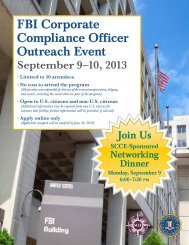Compliance & Ethics Professional - Society of Corporate ...
Compliance & Ethics Professional - Society of Corporate ...
Compliance & Ethics Professional - Society of Corporate ...
- No tags were found...
Create successful ePaper yourself
Turn your PDF publications into a flip-book with our unique Google optimized e-Paper software.
highly individualized. Leaders may find thatthey have removed the specific actor, but havedone little to alter the forces which motivatedthe undesirable act.which the ethical principles, guidelines, andprocesses <strong>of</strong> the organization are integratedwithin the organizational system.There are innumerable variations inbetween the two extremes, and each type <strong>of</strong>assessment is progressively more complex and<strong>of</strong>fers the client a set <strong>of</strong> data which is morecomprehensive. There is nothing wrong withany <strong>of</strong> them. Each serves a different purpose.What is wrong is when clients’ needs arenot served because they have received thewrong assessment for their desired outcomes.If, for example, the client organization has anexisting program to prevent and detect ethicsviolations and merely wishes to ensure that theprogram satisfies the requirements specifiedin the current iteration <strong>of</strong> Federal SentencingGuidelines for ethics violations, then a complianceassessment is an appropriate response.If the client suspects intentional orunintentional wrongdoing and wants tounderstand why it is occurring, then a culturalor systems assessment may be a better choice.One limitation <strong>of</strong> the compliance-orientedapproach is the difficulty managers may haverecognizing themselves in the findings andaccepting responsibility. <strong>Compliance</strong> assessmentsare narrowly focused and representa high degree <strong>of</strong> vulnerability to anyoneidentified as “out <strong>of</strong> compliance.” Thus,many leaders go to great lengths to distancethemselves from these types <strong>of</strong> findings.Interestingly, an organization’s first responseto negative findings is <strong>of</strong>ten punitive andGoing beyond complianceIf the organization wants to address the rootcauses <strong>of</strong> unethical behavior, then a systemsassessment may be the more effective alternative.For some, a compliance assessment maybe all that they know to ask for. These managersmay not appreciate what else might beaccomplished through a culture- or systemsfocusedethics assessment. Their assessor,especially if that service provider is a legalor financial pr<strong>of</strong>essional, also may not knowwhat to <strong>of</strong>fer, or have the wherewithal toprovide a more comprehensive and/or appropriateethics assessment alternative.There are two traditional ways to gobeyond a check on organizational and individualcompliance: the cultural assessment andthe systems assessment.Cultural assessments have been usedextensively by management consultants overthe years. They assess perceptions and identifyissues relating to how specific groups<strong>of</strong> stakeholders view targeted aspects <strong>of</strong> anorganization, such as leader effectiveness,decision-making, and change management.Their inherent limitation is that they, like thecompliance assessment, do not identify underlyingcauses.Several years ago, some managementconsulting firms that had become involvedin ethics management, including NavranAssociates, saw the value <strong>of</strong> applying “systems”methodology to ethics questions (e.g.,employee perceptions <strong>of</strong> leader integrity, theeffectiveness <strong>of</strong> ethics policies, confidencein ethics systems, and the effectiveness <strong>of</strong>employee hotlines in informing and changingbehaviors) as a supplement to complianceassessments.<strong>Compliance</strong> & <strong>Ethics</strong> <strong>Pr<strong>of</strong>essional</strong> March/April 2012+1 952 933 4977 or 888 277 4977 | www.corporatecompliance.org 47




